One hundred and eleven years ago today was the Tunguska Event, a massive explosion that is now believed to be the largest meteoroid impact event in modern recorded history. Thankfully, it occurred in the wilderness and no one was hurt, but the story could have been very different. Every June, those of us in the planetary defense community commemorate this event with Asteroid Day.
As we approach the halfway point in 2019, it is a good time to reflect on the progress we’ve made over the last year towards protecting our planet from future impacts.
To begin, the Dawn mission came to a close last November after a decade in deep space. The electrically-propelled spacecraft made history by orbiting not one but two main-belt asteroids, 4 Vesta and 1 Ceres. The spacecraft remains in orbit of Ceres, powered down and uncontrolled after exhausting its supply of attitude control propellant.
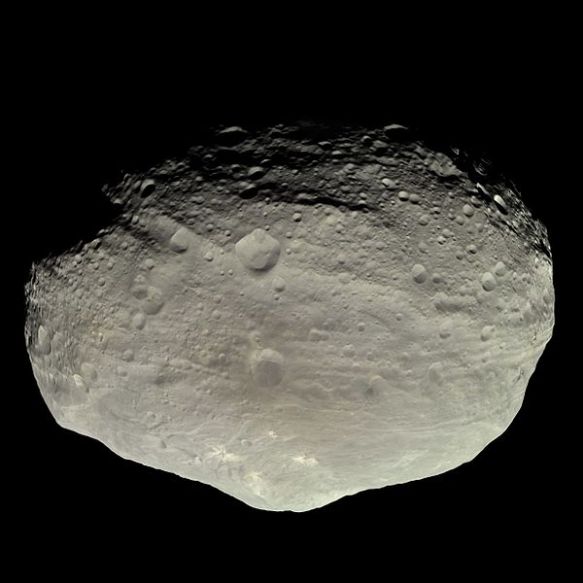
Vesta imaged in true-color by the Dawn spacecraft.
Source: Planetary Society
Main-belt asteroids pose a negligible threat to Earth; most follow relatively stable orbits without crossing the paths of Mars or Jupiter. There’s some small chance that gravitational interactions (cumulative perturbations by Jupiter or close encounters with the larger denizens of the belt, like Ceres) could fling one of the smaller rocks onto a collision course, but such possibilities do not represent a major area of concern compared to the under-charted asteroids that lay closer to Earth.
Rather, the planetary defense contribution of the Dawn mission follows from better planetary science—an improved understanding of asteroid formation and development, specifically. By studying not one but two considerably-separated asteroids, observations from Dawn enable scientists to better conceptualize the evolutionary processes of the Solar System, including the role that impacts play on planetary bodies.
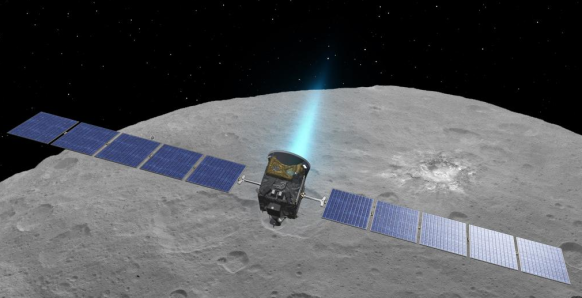
Artist impression of Dawn performing orbital insertion at Ceres.
Source: NASA/JPL-Caltech
Closer to home, two missions I reported on last year have begun major scientific operations at their targets.
Japan launched the Hayabusa2 spacecraft in 2014, and since last summer it has been orbiting the asteroid 162173 Ryugu. It follows the previous Hayabusa mission, which returned samples from the asteroid 25143 Itokawa to Earth in 2010.
JAXA partnered with the German Aerospace Center, French National Centre for Space Studies, and several Japanese universities to develop a set of “rovers” for exploring the surface of Ryugu. The word rover here is somewhat idiosyncratic, as none of the designs use wheels for traversing the surface of the asteroid. Instead, the probes generate torque internally, and use this momentum change to hop around Ryugu.
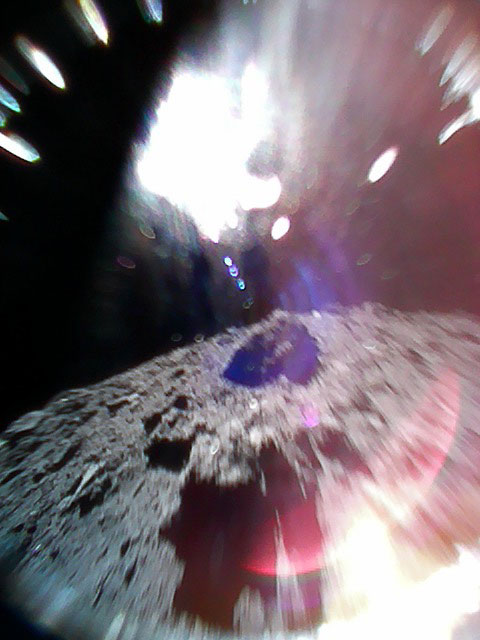
An image taken mid-hop by Rover-1A shortly after landing on Ryugu in September 2018.
Source: JAXA
Three of the four rovers have successfully landed on the surface of Ryugu, with a final landing planned for July.
In the meantime, Hayabusa2 has followed in its predecessor’s footsteps by collecting a surface sample for return to Earth. This was originally planned for October of 2018, but flight controllers delayed the operation until February of this year after discovering that Ryugu’s terrain is significantly less even than scientists had predicted. An additional experiment, currently underway, will dislodge some of the asteroid’s surface material, allowing Hayabusa2 to retrieve a sub-surface sample. Both samples will be returned to Earth in 2020, allowing scientists to better characterize the composition of this near-Earth asteroid.
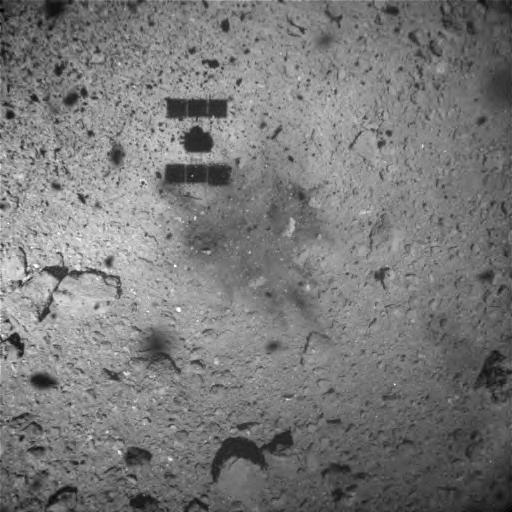
The surface sample collection site, imaged shortly after the spacecraft began its return to orbit.
Source: JAXA
The OSIRIS-REx mission is running into similar issues in its attempt to retrieve a sample of asteroid 101955 Bennu, which in addition to an unexpected number of boulders also features plumes of particles erupting from surface. NASA launched the spacecraft in 2016 and placed it into orbit last New Year’s Eve. Provided the sample recovery is successful, a piece of Bennu will arrive at the Utah Test and Training Range on September 24, 2023.
In the meantime, OSIRIS-REx will continue its scientific investigations. This includes a direct application to planetary defense: there is a slight possibility that Bennu will pose a hazard to Earth at some point in the distant future, and the mission will be studying the trajectory of this asteroid in particular, as well as the general effects of solar radiation on the orbits of small celestial bodies. Those plumes may also be contributing some non-trivial momentum change to the object, which could prove an important facet of the orbit propagation problem which scientists could not have considered until 2019.
Beyond the preponderance of boulders, as many of us describe it, there is another notable similarity between Ryugu and Bennu. Despite significantly different sizes, both asteroids have a relatively similar shape.
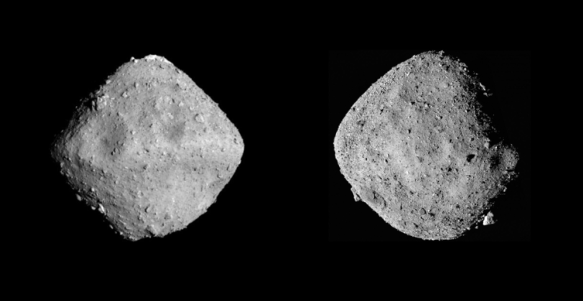
Asteroids Ryugu (left) and Bennu (right), not shown to scale.
Both asteroids display a sort of equatorial ridge, which probably tells us something about the internal material and mechanical composition of the objects. The ridge is more pronounced on Ryugu, which has about thrice the diameter of Bennu. Given that other near-Earth asteroids such as Itokawa or 433 Eros have clearly irregular shapes, this is a very interesting observation.
To me, this illustrates the scientific value of conducting missions to multiple targets. We could have decided after the NEAR-Shoemaker mission to Eros that we knew everything important about near-Earth asteroids, and moved on to other ventures. Because we didn’t, we learned how much we had yet to learn, and the full value of continuing our exploration. Everything would be fine, right? Right?
Ryugu and Bennu offer us tantalizing insights into the orbits and constitutions of near-Earth objects that could one day pose a threat to our planet. Without studying these in relatively high detail, we cannot realistically hope to deal with the risks they present.
As we better understand the dynamics of asteroids, the question then becomes: what can we do to prevent future impact events?
Right now, the answer is: not all that much.
Visiting an asteroid is one thing, returning samples from an asteroid is something else, and redirecting one is yet another still. The American and Japanese space agencies have developed the first and second capability, but no space agency is currently pursuing large-scale asteroid redirection.
This wasn’t always the case. Until 2017, NASA was developing a dedicated Asteroid Redirect Mission, or ARM. Such a mission would have involved sending an uncrewed spacecraft to a near-Earth asteroid such as Ryugu or Bennu—both were considered, along with Itokawa, on the list of potential targets—and retrieving a boulder from the surface. (At that time, it bears mentioning, we had less clear of a picture of how many boulders such an asteroid would have.) The spacecraft would have then returned to the Earth-Luna system, placing the boulder in a Lunar orbit. There, it could be visited and investigated by astronauts launched in Orion capsules, far more easily and safely than by rendezvousing with the larger asteroid in interplanetary space.
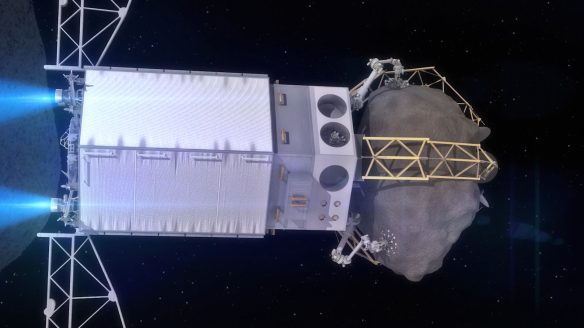
Artist rendering of the Asteroid Redirect spacecraft en route to Luna with its asteroidial boulder.
Source: NASA
Since its cancellation in 2017, there has been no major attempt to revive the ARM, despite some acknowledgement from the administration that planetary defense is an integral responsibility for a national space agency. Asteroid redirection would require a considerable technological investment in astrodynamics, propulsion, and robotics. NASA is planning to continue much of the work already completed, and may even be able to port this development to future manned and unmanned programs.
Currently, the American deep space effort is centering around the Artemis program, which folds together the Exploration Missions planned for the Space Launch System with the Deep Space Lunar Orbital Platform-Gateway. This is a sound objective for advancing astronautical engineering and planetary science. Nevertheless, I feel some concern about the tendency for our elected leaders to routinely shift gears on the human space program rather than follow through with any particular goal. If Artemis can buck the trend, then it may well serve as a stepping stone for developing our deep space capability in general, including for planetary defense purposes. We will have to wait and see.
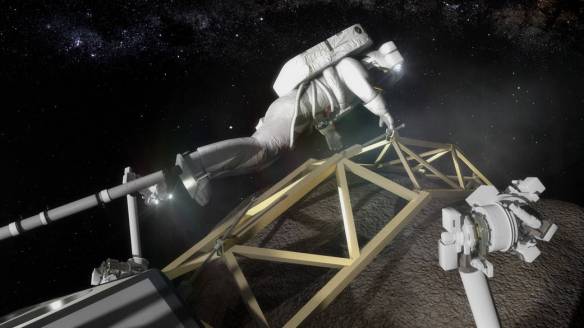
Artist rendering of an astronaut surveying the captured boulder in Lunar orbit.
Source: NASA
There has been some positive development, however: in the last year, the Double Asteroid Redirection Test received approval from NASA to finish the spacecraft design and begin assembly and fabrication. The Double Asteroid Redirection Test (or DART) is being built by the John Hopkins University Applied Physics Laboratory, and is planned to launch aboard a Falcon 9 launch vehicle in the summer of 2021 for an October 2022 arrival date.
DART’s goal is to study the binary asteroid 65803 Didymos, with a possible flyby of 3361 Orpheus en route. The spacecraft itself will carry essentially no scientific instrumentation, but is instead designed to impact the smaller of the two asteroids at high velocity, imparting a small overall velocity change. This will enable scientists to measure the long-term effect of a known impact on the trajectory of an asteroid. With sufficient warning, such an impactor could alter the orbit of a hazardous object such that it misses Earth entirely. Didymos is an ideal target for studying such deflections due to its binary nature.
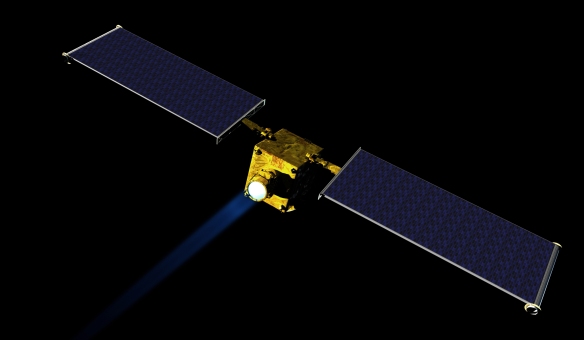
Artist rendering of the DART spacecraft.
Source: NASA
The DART spacecraft may end up operating in conjunction with one or more European probes. The Italian Space Agency is proposing a cubesat named LICIA (the Light Italian Cubesat for Imaging of Asteroids) which would fly along with DART, separating shortly before arrival at Didymos to observe the impact plume. So far, LICIA has not been approved, but is still under discussion between NASA and the Italian Space Agency.
Meanwhile, the larger European Space Agency is considering a spacecraft named Hera which would launch aboard an Ariane 6 rocket to arrive at Didymos in 2026. The spacecraft would image the DART impact site and study the binary asteroid system in greater detail. By observing the asteroids up-close, Hera will allow scientists to determine the impact of DART’s impact with greater precision than ground-based observations could alone.
The combined operation has the proposed name AIDA (Asteroid Impact and Deflection Assessment), though at this point it is unclear to what degree NASA and ESA will be coordinating their efforts. Both missions are being developed independently and will have considerable scientific and technological value on their own, but would yield even greater returns if flown together.
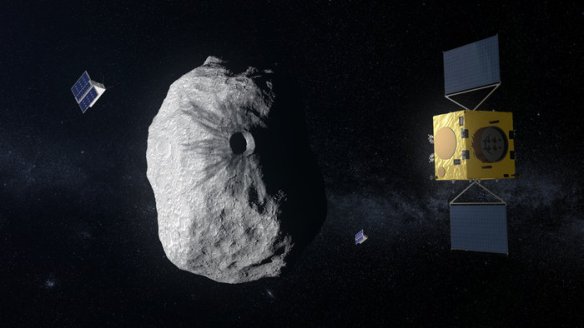
Artist rendering of Hera deploying auxiliary cubesats at Didymos. Note the crater left by the DART impact on the asteroid’s surface.
Source: ESA
We may soon have the capability to deflect asteroids that we see coming, but not every asteroid is detectable with our current technology. Ground-based telescopes and spacecraft such as the Wide-field Infrared Survey Explorer have discovered tens of thousands of asteroids across the Solar System, but only by looking outward from the sun. Right now, we’re basically blind to asteroids that spend most of their time inside Earth’s orbit. The destructive Chelyabinsk meteor was one such asteroid. It exploded with the energy of an atomic bomb.
The ideal solution, then, would be to place a dedicated space telescope in an orbit closer to the sun than Earth, from which it could search for asteroids that cross its orbit. Asteroids are generally dark, but much warmer than the cosmic background, so an infrared telescope would probably be the most effective approach.
The B612 Foundation proposed the Sentinel Space Telescope, which would have been placed in a heliocentric orbit near that of Venus. As I reported last year, the project was cancelled in 2017 due to insufficient funding. The Foundation is now pursuing better computational techniques for processing astronomical data, and putting cameras on smaller spacecrafts.
A similar such project is the Near Earth Object Camera, or NEOCam. This is a smaller spacecraft proposed by the Jet Propulsion Laboratory, which would orbit at the Earth-Sun L1 point and search for asteroids using the same basic technique.
NEOCam has certain advantages over Sentinel, including the fact that L1 is easier to reach than Venus. However, the proposal has been stuck at the “concept study” stage of development for the last two years, though it is nominally still under development at JPL. It has been passed over three times for mission opportunities through the Discovery Program. Most recently, NASA decided instead to pursue two asteroid-focused missions instead, Lucy and Psyche.
The Lucy mission, named after the famous Australopithecus specimen, will explore the Trojan asteroids that orbit ahead and behind Jupiter in its L4 and L5 Lagrange points. These asteroids have never been studied at close range, which makes Lucy an exciting opportunity to characterize a new population of space objects. Scientists expect to uncover clues about the formation and evolution of the Solar System, hence the mission’s name.
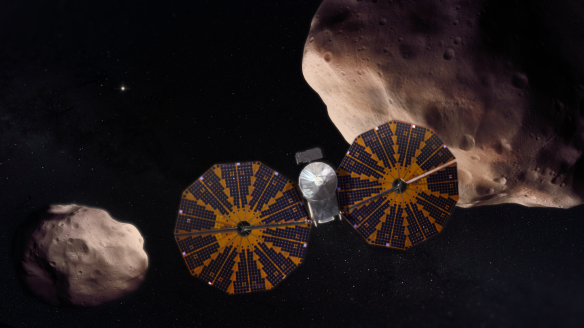
Artist rendering of Lucy encountering the asteroid 617 Patroclus and its moon Menoetius in the trailing group of Jupiter’s Trojan asteroids.
Source: NASA
The Trojan asteroids represent no threat to Earth, but there is still a planetary defense benefit. Understanding another group of asteroids will enhance our broader picture of the similarities and difference between classes of deep space object. We will have to wait some time to gain that understanding, however. Lucy is scheduled launch in 2021 aboard an Atlas V rocket, flying by a main-belt asteroid in 2025 and arriving in the leading “Greek” camp around 2027. It will transfer to the trailing “Trojan” camp via the inner Solar System, arriving in 2033. Six asteroid flybys are currently planned, but I expect this number will grow as the flight plan matures.
Psyche is the other mission, intended to explore the main-belt asteroid 16 Psyche. It is one of the largest and most massive known asteroids. Based on observations from Earth, scientists suspect that the asteroid may be the iron core of a protoplanet left over from the formation of the Solar System. The Psyche mission is planned to launch in 2022 and arrive at the target in 2026 following a gravity assist from Mars.
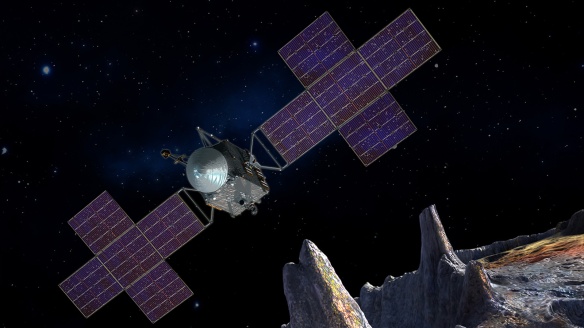
Artist rendering of Psyche in orbit of asteroid 16 Psyche.
Source: NASA/JPL-Caltech
Under the overlapping systems of asteroid spectral classification, Eros and Itokawa are rocky S-type asteroids, while Bennu and Ryugu are different variants of carbonaceous C-type asteroids. Psyche is a primarily-metallic M-type asteroid, none of which have been investigated in detail.
Because metallic asteroids are just as liable to cross Earth’s orbit as any other type of asteroid, investigating their properties is an equally useful component of our planetary defense effort. The spacecraft will focus on studying the geology of the asteroid, but those lessons may prove important for asteroid deflection at some point in the future.
To conclude this progress report, I want to discuss a final mission under development, this one by Japan. Thus far, we’ve mostly been focusing on the impact threat posed by asteroids, and largely neglecting the danger posed by comets. This is understandable—comets tend to be more visible than asteroids. Consequently, astronomers can much more easily identify and determine the orbits of comets that pass through the inner Solar System fairly regularly. Longer-period comets (think Hale-Bopp, not Halley) pass near Earth infrequently, so we cannot realistically characterize their orbits until they actually arrive. Such comets are fairly rare, however, and sometimes disintegrate on approach, so these present a much smaller hazard than asteroids.
Distinguishing between comets and asteroids can get kind of fuzzy, leading to the strange concept of a “rock comet“. JAXA is developing a mission to visit one of these bodies, 3200 Phaethon, which seeds the Geminids meteor shower.
The mission is called DESTINY+, which I regret to inform you is an acronym standing for Demonstration and Experiment of Space Technology for INterplanetary voYage Phaethon fLyby dUst Science. I am perfectly confident that I could come up with a less strained name given my track record with backronyms—but nobody at JAXA asked for my opinion.
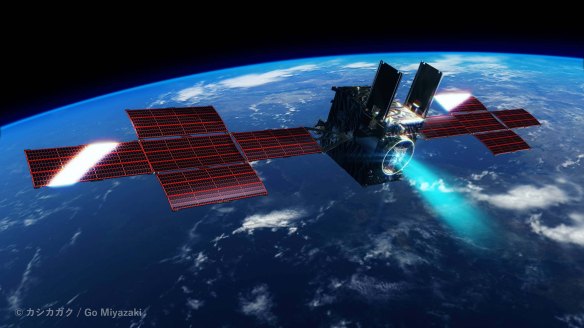
Artist rendering of DESTINY+ departing Earth orbit using electric propulsion.
Source: JAXA
DESTINY+ is expected to launch in 2022 and spend over a year raising its orbit using electric propulsion. A Lunar flyby will propel it into interplanetary space, and it will encounter Phaethon several years later. The primary focus of the mission is characterizing the dust released by Phaethon and other asteroids, as well as from the interstellar medium. The spacecraft may, thanks to its electric propulsion system, place itself on flyby trajectories for other deep space objects, further enhancing the science gain.
Though not primarily focused on planetary defense, DESTINY+ may still make a contribution to keeping Earth safe. Phaethon is a potentially hazardous object, occasionally making close approaches to our planet. Astronomers have calculated Phaethon-Earth encounters and concluded that it will not post a threat for several hundred years. Data from DESTINY+ may enable us to extend this estimate considerably.
In a sense, that encapsulates the current planetary defense situation as a whole. Some technological development is underway on asteroid deflection and orbit determination, but planetary science remains the main objective of the space agencies currently conducting deep space missions.
Scientific research is a worthy goal, but we should be making the investment now to prevent further catastrophes. The Chelyabinsk and Tunguska blasts have shown us the destructive power of comets and asteroids—a destructive power that, to date, humanity has made very little effort to deflect. In the past year, the space agencies of America, Europe, and Japan have made significant strides in rectifying our vulnerability. My hope is that over the next year, we will see even greater progress in developing the technology and scientific knowledge to predict and prevent impact events.
